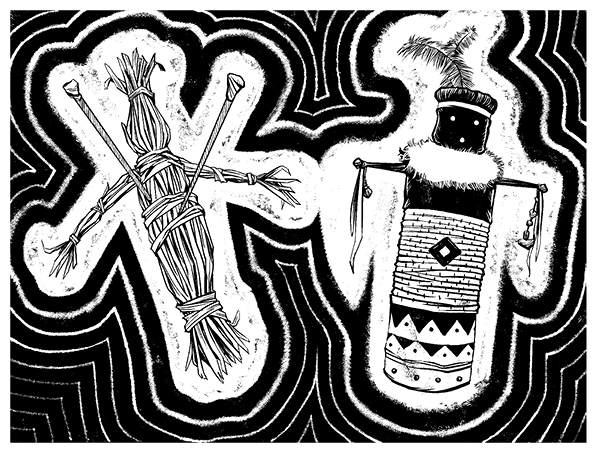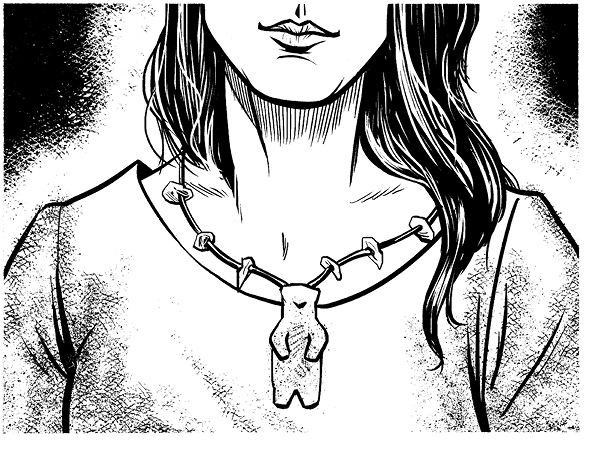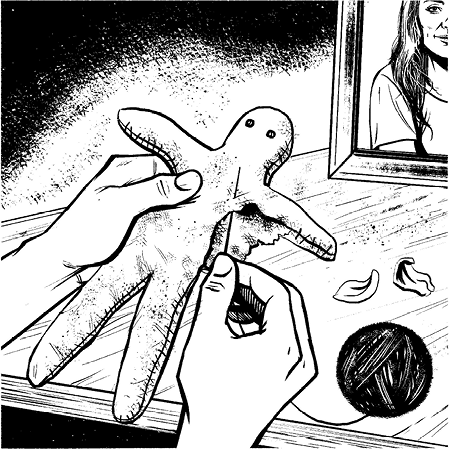by Charlie Rainbow Wolf
No one knows exactly when the first doll was created, but there is evidence that they have been part of the human experience since prehistoric times. Sometimes they were religious items, dedicated to gods and goddesses; other times, they were simple playthings. The earliest dolls were made from primitive materials. You might think that as humankind advanced the dolls would grow to be more sophisticated, and to an extent you’d be right. However, even today, dolls are made from corn, wood, and other natural fibers, as well as manufactured as brightly colored, plastic toys seen in the aisles of department stores.
Initially, dolls were quite crude, but in an attempt to make them more lifelike, they evolved to have moveable arms and legs and also their own garments. In Egypt, Greece, and Rome, there’s evidence of dolls being placed in tombs of the wealthy. It’s thought, because of this reverence, that dolls were cherished and important. Most of these were very simple creations, but some were more elaborate and made from pottery or even alabaster.
Some of the traditions have endured through time. There are many ritual and spiritual uses for dolls today that can be traced back through the ages. Whether to heal, to help with divination, to assist with magic, or to honor deities or deceased loved ones, dolls are as much a part of spiritual practice in the modern world as they were during the times of our ancestors.
Poppets
Mention poppets to people, and they usually think of Voodoo. The truth is that these dolls—sometimes called handkerchief dolls, church dolls, or pew dolls—have been used in sympathetic magic for millennia. Wax images were popular dolls, as they could be molded to look like specific deities or people, they could be manipulated to cause harm or good, and they could be destroyed (melted) once the magic had been done.

Today, poppets can be made with a myriad of materials, from wax to wood, from cloth to clay. Poppets have a long tradition of history, and they can be used for a variety of reasons and in a cross section of ceremonies and traditions. They are not limited to Voodoo dolls, but, rather, poppet is the name for any doll that is used for some kind of sorcery or Witchcraft.
Voodoo Dolls
These dolls are a specific type of poppet. Hollywood frequently portrays them as figures with pins sticking into them in order to hurt figures they represent in some way. This is largely a product of sensationalism, associating Voodoo with zombies and an inaccurate perception of Satanism. While the film industry and many occult sites are quick to promote dolls to curse, control, or harm, the truth is that most practitioners of Voodoo use pins to focus energy rather than to do evil! The media has a lot to answer for.
Voodoo dolls are often depicted as having some kind of supernatural power over the person to whom they’re attached. The dolls themselves have no power. What gives them any importance at all is the vibration and intent that the maker and user apply to them. The movies show us that a Voodoo doll can control what we do, but the truth is that we alone determine what controls us—although in sympathetic magic there can be a lot of subtle influence.
Muñequitas
These are dolls that are associated with the religions of Espiritismo and Santería. Here, the dolls can represent deceased loved ones, saints, and ancestors. They are part of the household, and stories are told about them—and to them. The dolls are not placed upon the home altar, but rather they have their own honored place in the house, where they can still be among the family.
The dolls are not just for decoration. They are believed to be able to communicate to those who live there. Some represent spirit guides. Others are said to represent deceased family, and when the dolls are dressed, they are done so to honor that family member. Sometimes the dolls are handmade, but it is not unusual to see a mass-produced doll that has been clothed and adorned to represent the family member. Like the spirits of the deceased, the dolls are a part of the family to their owners and reverently passed down from parent to child.
Spirit Dolls
Similar to the muñequitas are the spirit dolls (sometimes called altar dolls) that Wiccans and other Pagans use. They are used as a focus for energy or as a means for communications with the spirits. Usually there’s one doll per energy or entity, so if more than one deity or being is being invited, more than one doll should be used. The purpose of a spirit doll is to give the helper spirits a place to stay while they are assisting you.

Once the spirit doll has been activated, it has to be cared for. Offerings of food, drink, incense, or candles can sweeten the doll’s energies. Usually with magic or ritual, the more you put into it the more you get out of it, so the more you care for your doll, the more harmonious and helpful the energies between you and it are going to be. An altar doll may not always stay with you, though. The spirit may need to leave the doll because it has fulfilled its role or helped you as much as it can. It could also be that it is time for the spirit and the doll to move on to someone else, in which case the owner of the doll often gives it to that person, so that the spirit in the doll can continue the work it is called to do.
Fetishes
A fetish is another kind of doll, similar to a poppet, but instead of representing a particular person or energy, this doll possesses spirits that connect it with its owner. It’s used as a charm: sometimes worn, sometimes carried. It is said to contain a lot of power, and at one time, a slave could be killed for being found with a fetish doll on his or her person.
It wasn’t just slaves who carried fetishes, though. Native Americans also worked with fetishes. The most well known of these is probably the Zuni fetish animal necklaces, which are made of stones carved into the shapes of animals. These carvings give the spirits of animals a place to live while they are helping the wearer of the fetish. Fetishes may also be made out of wood, shell, or bone, and can represent nature spirits as well as animals. Nearly anything can be carried or worn as a fetish once the owner infuses it with that power.
Corn Dollies
These are just what they sound like they are: dolls made out of corn. In this case, the corn was the last wheat of the season. Here the spirit of the corn resided until the next year, kept safe and given a revered place in the home. Often the corn dollies didn’t resemble a figure but rather a sacred geometrical shape. They were decorated with ribbons and flowers and sometimes given to sweethearts as a token of affection. These corn dollies originated in Europe but have spread throughout the world.
Native Americans had their own version of the corn dollies, the corn husk doll. It’s said that it originated with the Oneida or other Iroquois nations, but all nations who grew corn would have had a version. As well as being toys for children, corn husk dolls are also used in healing ceremonies and other practices. The Iroquois nations used them to help purge nightmares. A doll was made to absorb the dream, and then it was buried so that the negative energy returned to the earth. The dolls are usually made without faces because of an Oneida legend. The story goes that a beautiful corn husk doll became so enamored with her appearance that she forgot to tend to the children. Making the dolls without faces teaches us to be humble and to take care of our responsibilities.
Make a Poppet
It’s easy to make your own poppet. It can be as simple or elaborate as you desire. Just remember that it is a representational object; it needs to represent a person, a deity, or an energy. You also need to determine the purpose for the poppet; it can be for protection, to stop gossip, for safe travel—pretty much anything can be embodied in a poppet. Just get your idea firmly in your head so that you don’t have to start over! Making the poppet is as magical as the actual poppet itself.

Next, you will want to choose your fabric. Take some time with this. For example, if you want to draw love, you might choose pink. Blue would be good for health, while green might be chosen for money spells. If you can use fabric that in some way links you with the person or the energy that you want to use, so much the better. For example, if you want to draw a lover into your bed, you might want to use fabric from your pajamas or the bed sheets. See how it connects?
Cut the fabric in the shape of a human. If you’re making this with a specific person in mind, try to emulate him or her. If the person is chubby, make the poppet chubby—that sort of thing. Sew the shapes together using your favorite method; hand or machine, it doesn’t matter. Remember to put the outsides of the fabric together when you sew the seams so that they are on the inside when you turn it inside out. Leave an opening for the stuffing.
What goes in your poppet? Well, you’ll want some old rags or even some polyester stuffing material that you can buy at craft shops. This doesn’t have to be anything fancy, but you do want to consider adding things to your poppet to help give it power. If you’re making a poppet for love, add rose petals, because roses are the symbol of love for many people. If you’re making the poppet for money, add a coin. Get the idea? If this poppet is to connect you with another person, you could add a taglock. This is something belonging to that person: a lock of hair, a fingernail clipping, a piece of their handwriting, or even a photograph.
Decorate the poppet however you want, but if it is going to represent that person, then put that person’s likeness onto it. For example, give it the same color hair, draw on any birthmarks or tattoos, or add a beard. Don’t forget to name your poppet, too! You don’t have to give it a person’s name, but you want to tell the poppet why it was created. If you made the poppet to serve as a token for someone in your life, then call it by that person’s name. Remember, the more you put into the doll, the more it will assist you in your ceremony, ritual, or magic. Intent is everything!